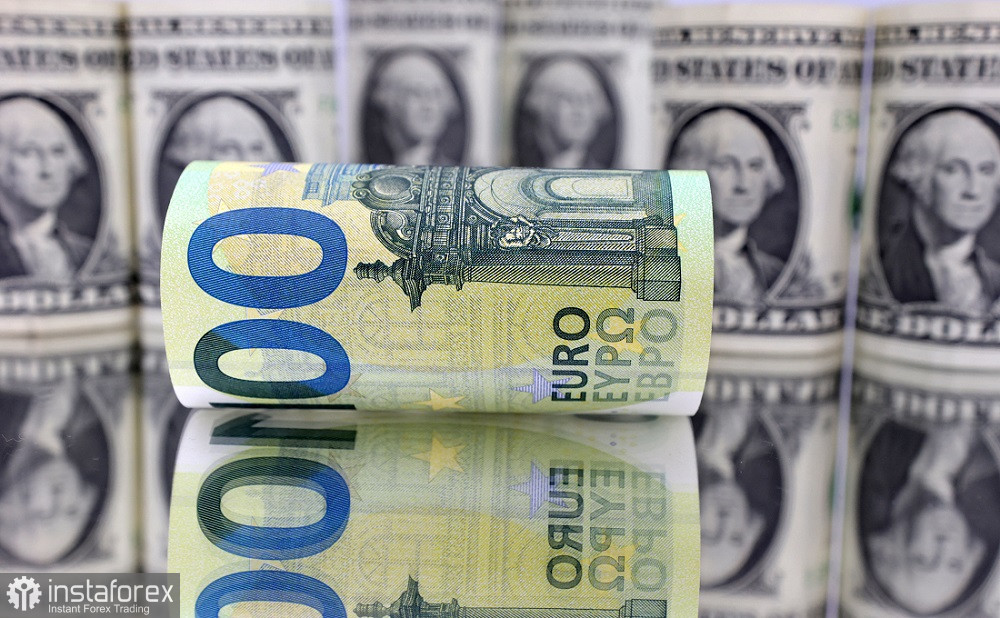The euro-dollar pair continues to trade within a wide price range, the scope of which is limited to 0.9660 (the lower line of the Bollinger Bands indicator on the H4 timeframe) and 1.0000. Over the past two weeks, the pair has been testing the boundaries of this range, but has not been able to overcome them. EUR/USD bulls need to go above the parity level (preferably anchored above the 1.0050 mark), and bears need to settle at the base of the 96th figure to declare the development of the downward trend. But traders are hesitant to take active steps. Monday's upward momentum, thanks to which EUR/USD bulls entered the area of the 98th figure, has successfully faded on Tuesday. Traders failed to cope with the intermediate resistance level of 0.9870 (the Kijun-sen line on D1), so there is no need to talk about the rapid development of the correction yet.
Monday's price increase was due to the general weakening of the greenback. Dollar bulls cannot find a foothold, while the US stock market showed positive dynamics on Monday, ending trading with an impressive growth. In particular, the S&P index updated a two-week high, after the release of quarterly reports of the largest American banks, such as Bank of America, Bank of New York Mellon and Wells Fargo.

In addition, interest in risk increased after a short (4-minute) speech by British Prime Minister Liz Truss, in which she apologized for the mistakes made and announced the "restoration of economic stability." She acknowledged that the anti-crisis plan, which has been widely criticized, will not be implemented in the form in which it was previously presented. Later, the newly appointed Finance Minister Jeremy Hunt clarified that the basic personal income tax rate would remain at 20%. The previously announced decision to reduce it (from April next year) to 19% has been canceled. In addition, Downing Street refused to reduce the tax on dividends and exempt guests from abroad from VAT. Hunt also announced a reduction in the period of freezing electricity and gas tariffs for British households from the previously promised two years to a modest seven months – "in order to avoid the growth of public debt."
In other words, Truss carried out "work on mistakes" that could have been avoided, given the widespread criticism of her initiatives during the election campaign. The prime minister refused to resign voluntarily, while the levers of influence of a coercive nature are not yet available to her opponents. According to the current party rules (which, however, theoretically can be changed), a vote of confidence cannot be announced until the party leader has been in power for at least a year.
In other words, investors came to the conclusion that the situation in the UK has somewhat stabilized: Truss abandoned the adventurous initiative and announced her intention to retain her position "until the next election."
Against this background, interest in risk increased, while the safe greenback was under pressure: the US dollar index fell to the area of the 111th figure (last week the index fluctuated within the 113th figure).
The indices published on Tuesday by the ZEW Institute also failed to support EUR/USD bears. Despite the fact that all indicators are still deep in the negative area, the release itself came out in the green zone. Thus, the German index of business sentiment came out at -59 points, while most experts expected a decline to -67 points (in September it came out at -61 points). The pan-European index showed similar dynamics, falling to -59 points with a forecast decline to -62 points. This is little consolation for EUR/USD bulls, but nevertheless, EUR/USD bears could not take advantage of the release. In the wake of the corrective pullback, the pair continued to drift within the 98th figure.
The main problem of EUR/USD bears is the lack of a powerful information driver that would help them resume the downward trend. After the release of the US consumer price index, the probability of the Federal Reserve raising the interest rate by 75 points in November increased to 97% (according to the CME FedWatch Tool). As for the December meeting, here the market is confident in the implementation of the 75-point scenario by 65%.
In other words, the very fact of a 75-point rate hike next month has already been practically won back by traders. If the representatives of the Fed tighten their rhetoric in the context of the December and subsequent meetings (for example, by allowing a "series" of 75-point hikes) or at least hypothetically allow the option of a 100-point hike, then dollar bulls will again find a second wind. But the Fed members who spoke earlier (Brainard, Mester) limited themselves only to general phrases. On Thursday, several representatives of the US central bank (James Bullard, Philip Jefferson, Lisa Cook and Michelle Bowman) are expected to speak at once – it is quite possible that they will provide significant support to the dollar with a more hawkish attitude.
But the current macroeconomic statistics are not able to support the greenback. The reports published this week can only reduce or increase the probability of a 75-point hike in December. Whereas the fact of an increase in the rate by this amount in November is already a "solved issue". And for the most part – won back by the market.
In conditions of such uncertainty for the pair, it is now advisable to take a wait-and-see position, since theoretically bulls can develop a corrective growth to 0.9950 (the upper line of the Bollinger Bands indicator on D1). But at the same time, longs are still risky, since the dollar may suddenly strengthen its position due to the growth of anti-risk sentiment, given the general geopolitical tensions in the world. Therefore, in my opinion, it is now more prudent to be out of the market for the EUR/USD pair.





















